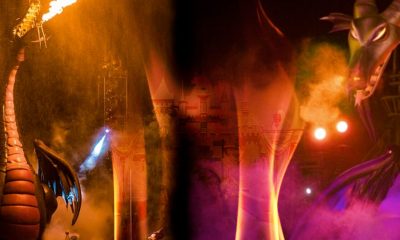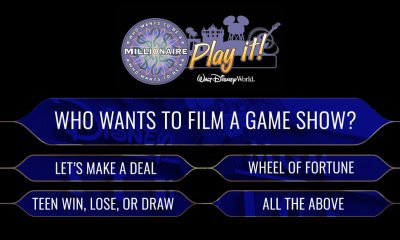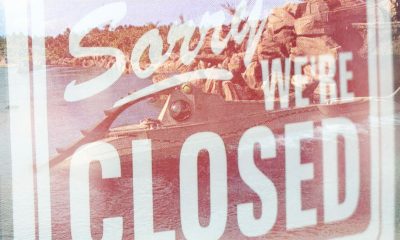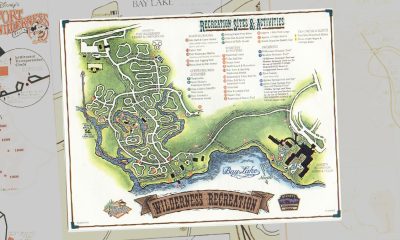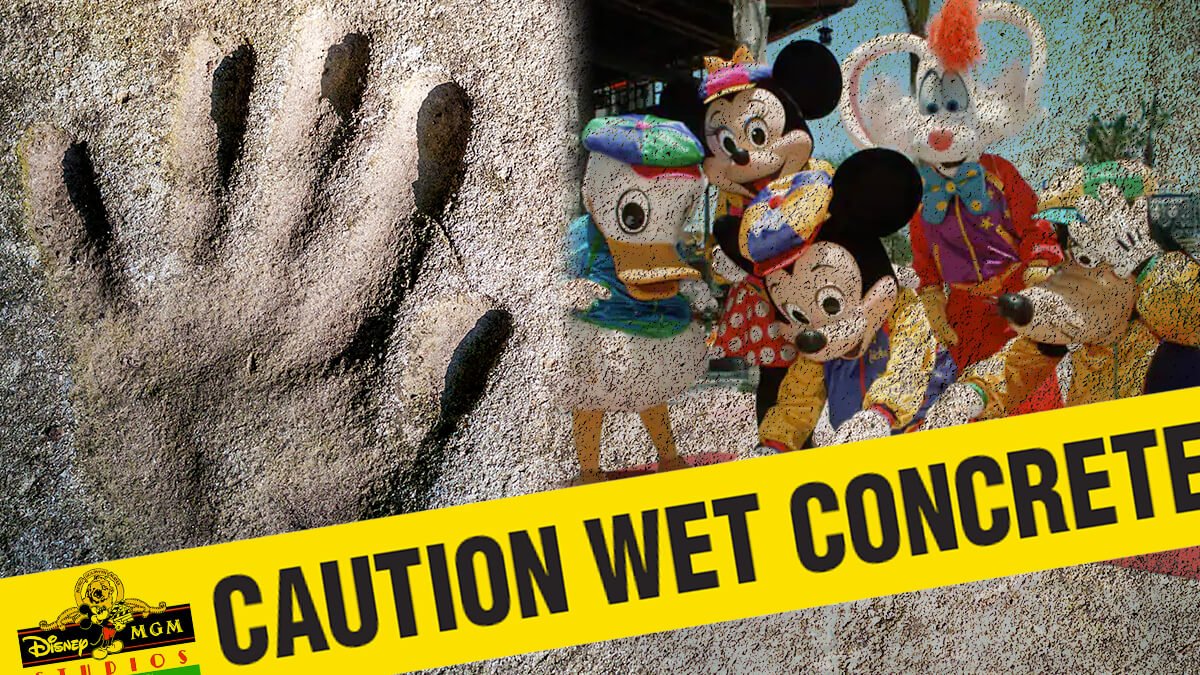
Not so long ago, we got a query from a “Disney Dish” listener about some of those concrete slabs that Guests can see over at the Theater of the Stars at Disney’s Hollywood Studios. These are the ones that feature the handprints, footprints & signatures of various celebrities. I believe the two slabs that we specifically asked about were the ones for Monty Hall & Bob Denver.
These were done back when Disney-MGM (Now Disney’s Hollywood Studios) used to have a “Star of the Day” program. Which …
Well, to tell this story properly, we really have to go back to when the original Grauman’s Chinese Theater (the building that the Chinese Theater – now home to “Mickey & Minnie’s Runaway Railway” – was modeled after).
Celebrity Handprints in Concrete – Grauman’s Chinese Theater Tradition
This ornate structure was built on the really-for-real Hollywood Boulevard back in the mid-1920s .
Mind you, this massive structure – which originally had seating for 2,200 people inside of one giant theater (but has since been subdivided into six smaller theaters . Which only have seating for 932 people now) – took 18 months to build. And as the story goes, Sid Grauman – the guy who originally funded the construction of Grauman’s Chinese Theater – was taking movie star Norma Talmadge on a tour of this still-under-construction massive movie palace (which cost $2 million to build. A huge sum back in the day).
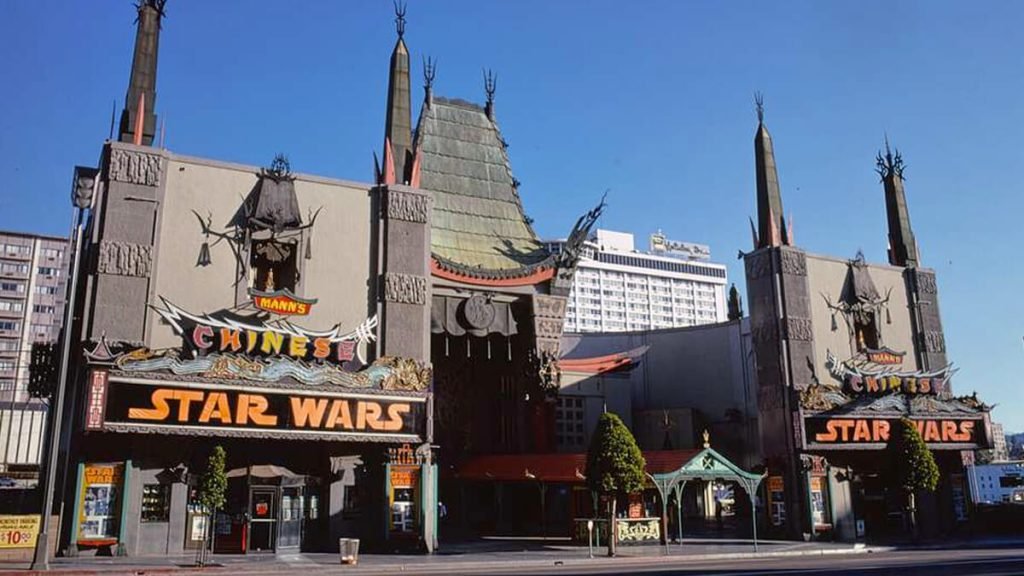
Anyway … Norma isn’t really watching where she’s walking. And as she’s touring this still-active construction site, Talmadge accidentally steps in some wet cement. Sid – who was already a master showman – looked at Norma’s footprints in that wet cement and immediately saw a promotional opportunity. He leaned over and – right next to Talmadge’s footprints – used his finger to quickly scribble Norma’s name and the date.
And thus a Hollywood tradition was born. Getting your footprints and/or handprints cast in cement so that they could then be displayed in the forecourt of the Chinese Theater. Back in the day, you weren’t really considered a star in Tinsel Town until Sid extended an invitation to you to come on down and do the whole step-in-wet-cement thing with the whole Hollywood press corps looking on. Not to mention all of your adoring fans.
Celebrity Cement Prints at Disney’s Chinese Theater
Okay. So the original Chinese Theater opens in May of 1927 . And the clone of this structure that Disney was building in Florida in the late 1980s .
FYI: The Imagineers used the exact same blueprints that Meyer and Holler – an architectural firm that was based in LA – originally drew up for Sid Grauman when they were building a copy of this movie palace to then serve as the central icon [the castle, if you will] of WDW’s third theme park
Well, then-Disney CEO Michael Eisner wanted the forecourt of Florida’s Chinese Theater to be just like the original in Hollywood. Which meant that the Imagineers needed to start collecting celebrities’ signatures in cement ASAP.
The first two modern day stars to be captured in cement for Disney-MGM were TV legend Carol Burnett and Cindy Williams, co-star of 1970s sit-com, “Laverne & Shirley.”
Carol Burnett
Burnett signed her cement block onsite at the still-under-construction Disney-MGM back on June 25, 1988 . She was down there then to film “A Conversation with Carol.” Which was one of the very first things to be shot at Disney-MGM. This one-hour-long look back at Burnett’s career was shot inside of the just-completed Soundstage 3 . The live audience that attended this taping had to hike across a muddy construction site in order to reach this soundstage. The completed show would then debut on the Disney Channel just two months later and then repeatedly air on that cable channel in the months leading up to the official opening of Disney-MGM.
Cindy Williams
Cindy Williams – on the other hand – did her cement handprint ceremony out in LA on the set of “Save the Dog.” Which was a TV movie that Cindy was shooting for Disney which would eventually air on NBC as part of that network’s “Magical World of Disney” programming block.
Shipping Cement Blocks from California to Walt Disney World
That’s the dirty little secret of the forecourt of the Chinese Theater at Disney-MGM (Now Disney’s Hollywood Studios). Because the Imagineers needed hardened cement blocks with celebrities signatures & handprints & footprints that they could then put into place prior to the official opening of this Studio theme park on May 1, 1989 … A bunch of these were done in advance far away from Florida.
The giveaway is the date. If you see a cement block with a star’s signature that says “ 1988 ” (EX: Alan Alda’s block), that was most likely done off-site well ahead of the official opening of this theme park.
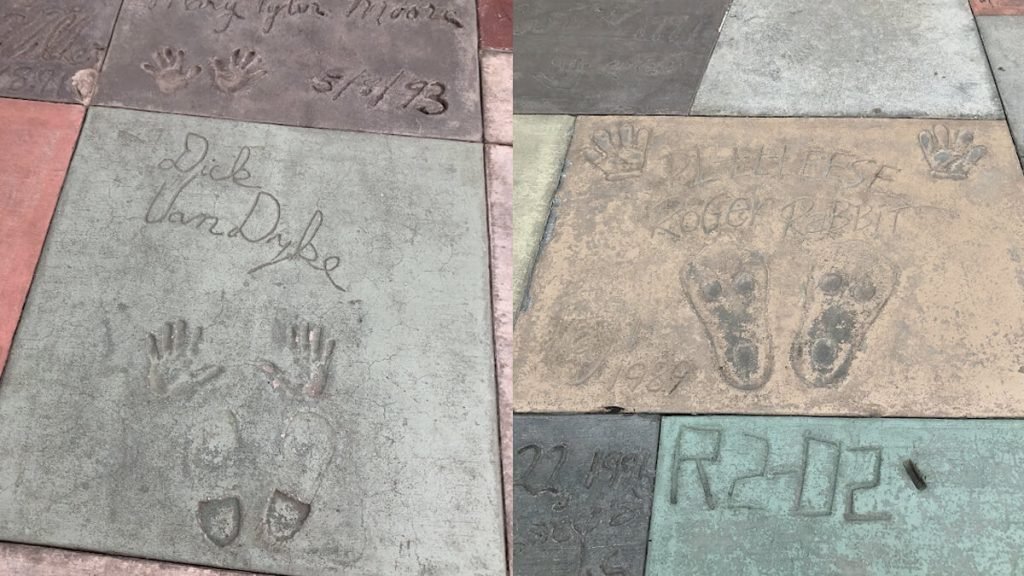
Disney-MGM Grand Opening
Mind you, for the actual grand opening of Disney-MGM (a three day-long affair that stretched from April 29 th – May 1 st ), there were celebrities galore on hand. And the Mouse deliberately staged several events in front of the press where multiple stars pressed their hands in wet cements (at the same time, mind you) in front of the cameras.
Among the stars who did this as part of Disney-MGM official grand opening were Bette Midler & Kevin Costner. There were also representatives from Hollywood’s golden age like Mickey Rooney & Ann Miller. Former glamor girls like Lauren Bacall & Audrey Hepburn. Television pioneers like Buffalo Bob of “Howdy Doody” fame, Imogene Coca and Edie Adams. Sitcom stars from the 1960s like Rose Marie & Morey Amsterdam. Not to mention Werner Kempler (Colonel Klink from “Hogan’s Heroes”).
Entertainment legends like Bob Hope & George Burns. Top music stars like Willy Nelson & the Pointer Sisters. Disney Legends by Annette Funicello & Art Linkletter. Not to mention modern day icons like Walter Cronkite, Leonard Nimoy and Dick Van Dyke.
And Disney did their damnedest to capture all of these celebrities’ signatures & handprints & footprints in cement. Which – after they dried & hardened – were then dropped in the forecourt of the Chinese Theater at Disney-MGM.
“Star of the Day” at Disney-MGM
The week that WDW’s third theme park first opened , Disney-MGM then kicked off its “Star of the Day” program. FYI: Annette Funicello officially kicked this program off.
This is the typical schedule that Disney-MGM’s “Star of the Day” program followed (FYI: There were typically two “Stars of the Day” each week at this theme park. One would appear Monday – Thursday . Then the second star would make appearances at Disney-MGM from Friday – Sunday .
Sweet gig. Disney would fly celebrities who’d agreed to part of MGM’s “Star of the Day” program into Orlando. They put these people & their immediate families up at the Grand Flo. Given them free admission to the Parks / assign them a Plaid to make sure that they never waited in line for anything. Comped all of their meals. Their hotel room as well.
All Disney asked in return was three hours of that celebrity’s time each day that they agreed to be a part of MGM’s “Star of the Day” program. They’d be picked up at the Grand Flo each day at Noon and then travel by town car backstage to the Studio theme park. Once there, they’d have a quick hair & make-up session. Then …
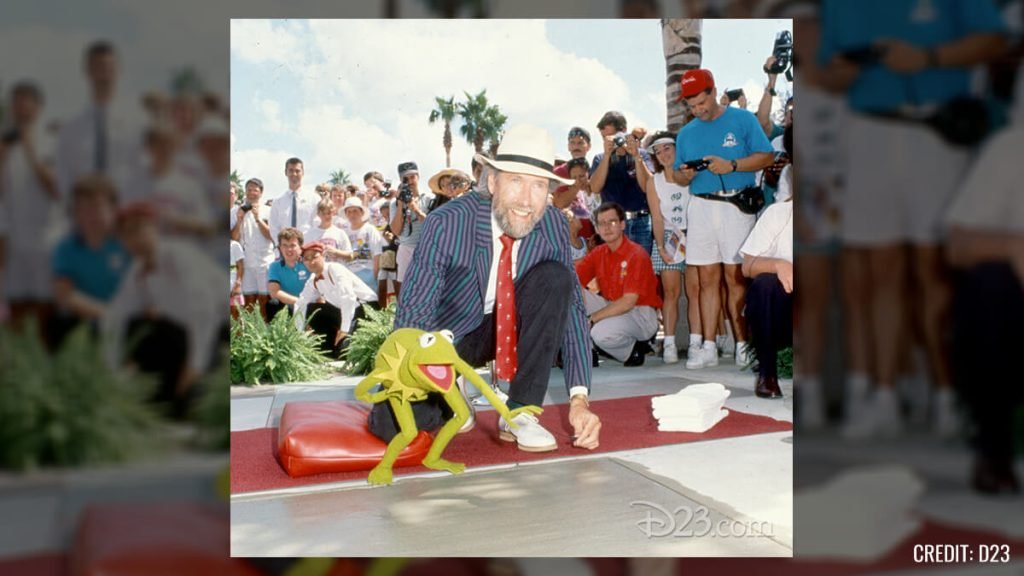
“Star of the Day” Celebrity Schedule
This celebrity’s day in the Park would typically kick off at 1 p.m. with a “Star Conversation” in the Theater of the Star (This was back when that outdoor performance venue was located just off of Hollywood Boulevard next to the Brown Derby), where this performer would then answer questions that Guests in the audience of this show would ask. At 2 p.m. , it was then time for this celebrity to then ride up Hollywood Boulevard while seated in an open convertible. They’d then take part in a public handprint ceremony that was staged in front of the Chinese Theater and then pose for some pictures out in front of that building.
By 2:30 p.m. , this “Star of the Day” was now off the clock. The Plaid that was assigned to them would now run this celebrity back to the Grand Flo and/or take them to wherever their family was playing on property. Like I said earlier, sweet, sweet gig. Basically a free WDW vacation for you & your family in exchange for three hours of being adored by the theme park-going public. What celebrity would say “No” when offered this gig.
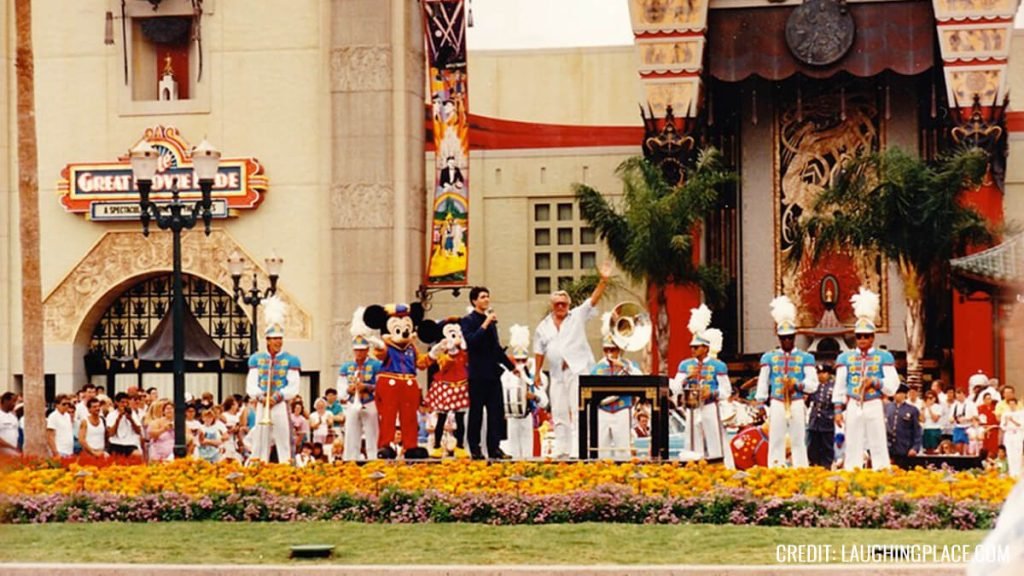
FYI: A lot of folks said “Yes” when offered an opportunity to take part in the “Star of the Day” program when Disney-MGM was still relatively new because they themselves were curious about the Park / wanted to check out the Company’s new state-of-the-art soundstages, etc.
We were just talking about people taking pictures of those celebrities out in front of the Chinese Theater pressing their hand into the cement … If you didn’t bring your camera to Disney-MGM and then couldn’t capture an image of this performer in action … Well, if you wanted an official 5 by 7 black & white image of that “Star of the Day,” all you had to do – when you were leaving Disney-MGM for the day – was swing into Guest Relations. They always had a stack of free pile of official images of that day’s “Star” to then give away to Guests there.
Are There Multiple Concrete Slabs with Celebrity Prints?
Yes, I’ve been told by folks who worked at Disney-MGM during the height of that theme park’s “Star of the Day” program (which was largely discontinued in the mid-1990s once Sunset Boulevard & Twilight Zone Tower Terror opened) that – yes – they’d wind up with multiple slabs of hardened concrete with that celebrity’s signature in them.
If a decision was eventually made to install that celebrity’s slab in the forecourt of the Chinese Theater at Disney-MGM, they’d actually gather those three or four cement slabs that this celebrity had signed over their stint as “Star of the Day” at that theme park and then decide which was the best looking slab with the easiest-to-read signature. Some celebrities have horrible handwriting.
If a celebrity really messed up when doing their slab as part of their public handprint ceremony, that one would then be trashed backstage. If they were all good, the multiples were then carefully catalogued and warehoused.
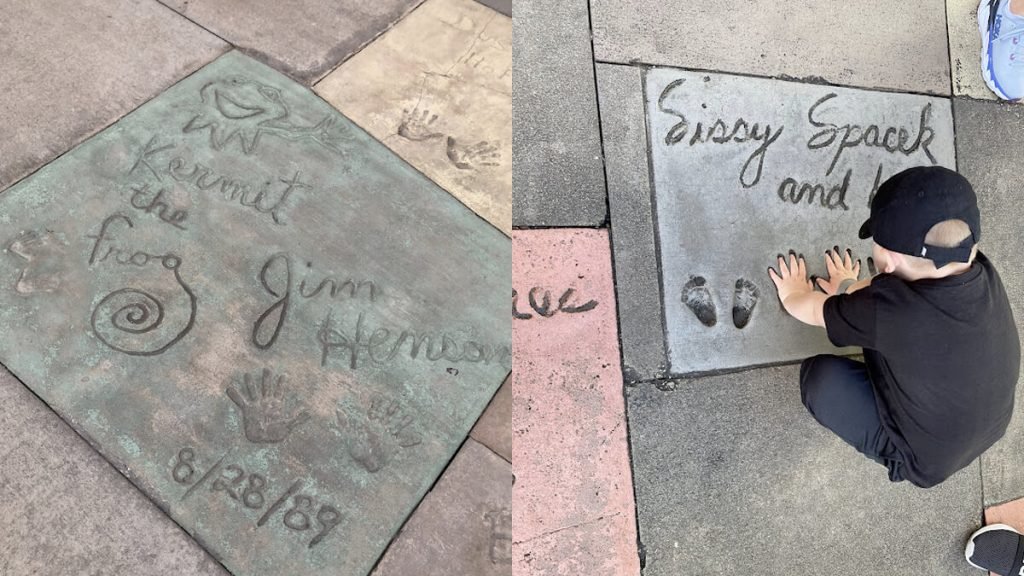
Concrete Slabs at the “Theater of the Stars”
This brings us to Bob Denver & Monty Hall’s cement slabs (The ones on display in the Theater of the Stars). When the decision was made to relocate this performance venue from the edge of Hollywood Boulevard over to Sunset Boulevard when WDW’s third theme park was being expanded in 1993 & 1994 … The decision was made to place the cement blocks of television legends in that space. Which is when the Imagineers went back into the warehouse, pulled out a number of the signed cement blocks that celebrities had done as part of the “Star of the Day” program that weren’t already on display in the Park and … Well, picked the performers with the strongest name recognition AND the best / clearest handwriting.
Quick note to Mr. Iger: You’ve got a warehouse full of cement blocks with celebrities’ signatures on them. Many of these folks were screen & television legends that are no longer with us. If I were Bob, I’d reach out to Van Eaton and hire them to auction some of those suckers off.
Experiencing the “Star of the Day” Program
I was there for the press opening of Disney-MGM ( 34+ years ago ). Almost got a broken neck from my head constantly whipping around at all the celebrities who were there in the Park for this event. People like Rick Moranis & Jim Varney. Three of the four “Golden Girls” (Betty White, Rue McClanahan & Estelle Getty). Comedy legends like Steve Allen & Tony Randall. Disney Legends like Jimmy McDonald (Got all sorts of stories from him about working with Walt as part of an interview I did with him at the event. Really need to dig out that tape at some point). Likewise Charles Fleisher, the voice of Roger Rabbit (Very funny guy. Kind of crazy, though).
If you want to get a sense of who actually took part in Disney-MGM’s “Star of the Day” program (because not all of those cement blocks with celebrity signatures wound up being displayed in the forecourt of the Chinese Theater or over in the Theater of the Stars off Sunset), go to Mama Melrose. There – in the waiting area of that Muppets Courtyard restaurant – you’ll see dozens of those black & white 5 & 7 images that I was telling about. Those cards that Guest Relations used to give away of the “Stars of the Day.”
This article is based on research for The Disney Dish Podcast “Episode 426”, published on May 8, 2023. The Disney Dish Podcast is part of the Jim Hill Media Podcast Network .

History
The Evolution and History of Mickey’s ToonTown

Disneyland in Anaheim, California, holds a special place in the hearts of Disney fans worldwide, I mean heck, it’s where the magic began after all. Over the years it’s become a place that people visit in search of memorable experiences. One fan favorite area of the park is Mickey’s Toontown, a unique land that lets guests step right into the colorful, “Toony” world of Disney animation. With the recent reimagining of the land and the introduction of Micky and Minnies Runaway Railway, have you ever wondered how this land came to be?
There is a fascinating backstory of how Mickey’s Toontown came into existence. It’s a tale of strategic vision, the influence of Disney executives, and a commitment to meeting the needs of Disney’s valued guests.
The Beginning: Mickey’s Birthdayland
The story of Mickey’s Toontown starts with Mickey’s Birthdayland at Walt Disney World’s Magic Kingdom. Opened in 1988 to celebrate Mickey Mouse’s 60th birthday, this temporary attraction was met with such overwhelming popularity that it inspired Disney executives to think bigger. The idea was to create a permanent, immersive land where guests could step into the animated world of Mickey Mouse and his friends.
In the early ’90s, Disneyland was in need of a refresh. Michael Eisner, the visionary leader of The Walt Disney Company at the time, had an audacious idea: create a brand-new land in Disneyland that would celebrate Disney characters in a whole new way. This was the birth of Mickey’s Toontown.
Initially, Disney’s creative minds toyed with various concepts, including the idea of crafting a 100-Acre Woods or a land inspired by the Muppets. However, the turning point came when they considered the success of “Who Framed Roger Rabbit.” This film’s popularity and the desire to capitalize on contemporary trends set the stage for Toontown’s creation.
From Concept to Reality: The Birth of Toontown
In 1993, Mickey’s Toontown opened its gates at Disneyland, marking the first time in Disney Park history where guests could experience a fully realized, three-dimensional world of animation. This new land was not just a collection of attractions but a living, breathing community where Disney characters “lived,” worked, and played.
Building Challenges: Innovative Solutions
The design of Mickey’s Toontown broke new ground in theme park aesthetics. Imagineers were tasked with bringing the two-dimensional world of cartoons into a three-dimensional space. This led to the creation of over 2000 custom-built props and structures that embodied the ‘squash and stretch’ principle of animation, giving Toontown its distinctiveness.
And then there was also the challenge of hiding the Team Disney Anaheim building, which bore a striking resemblance to a giant hotdog. The Imagineers had to think creatively, using balloon tests and imaginative landscaping to seamlessly integrate Toontown into the larger park.

Key Attractions: Bringing Animation to Life
Mickey’s Toontown featured several groundbreaking attractions. “Roger Rabbit’s Car Toon Spin,” inspired by the movie “Who Framed Roger Rabbit,” became a staple of Toontown, offering an innovative ride experience. Gadget’s Go-Coaster, though initially conceived as a Rescue Rangers-themed ride, became a hit with younger visitors, proving that innovative design could create memorable experiences for all ages.
Another crown jewel of Toontown is Mickey’s House, a walkthrough attraction that allowed guests to explore the home of Mickey Mouse himself. This attraction was more than just a house; it was a carefully crafted piece of Disney lore. The house was designed in the American Craftsman style, reflecting the era when Mickey would have theoretically purchased his first home in Hollywood. The attention to detail was meticulous, with over 2000 hand-crafted, custom-built props, ensuring that every corner of the house was brimming with character and charm. Interestingly, the design of Mickey’s House was inspired by a real home in Wichita Falls, making it a unique blend of real-world inspiration and Disney magic.
Mickey’s House also showcased Disney’s commitment to creating interactive and engaging experiences. Guests could make themselves at home, sitting in Mickey’s chair, listening to the radio, and exploring the many mementos and references to Mickey’s animated adventures throughout the years. This approach to attraction design – where storytelling and interactivity merged seamlessly – was a defining characteristic of ToonTown’s success.

Executive Decisions: Shaping ToonTown’s Unique Attractions
The development of Mickey’s Toontown wasn’t just about creative imagination; it was significantly influenced by strategic decisions from Disney executives. One notable input came from Jeffrey Katzenberg, who suggested incorporating a Rescue Rangers-themed ride. This idea was a reflection of the broader Disney strategy to integrate popular contemporary characters and themes into the park, ensuring that the attractions remained relevant and engaging for visitors.
In addition to Katzenberg’s influence, Frank Wells, the then-President of The Walt Disney Company, played a key role in the strategic launch of Toontown’s attractions. His decision to delay the opening of “Roger Rabbit’s Car Toon Spin” until a year after Toontown’s debut was a calculated move. It was designed to maintain public interest in the park by offering new experiences over time, thereby giving guests more reasons to return to Disneyland.
These executive decisions highlight the careful planning and foresight that went into making Toontown a dynamic and continuously appealing part of Disneyland. By integrating current trends and strategically planning the rollout of attractions, Disney executives ensured that Toontown would not only capture the hearts of visitors upon its opening but would continue to draw them back for new experiences in the years to follow.
Global Influence: Toontown’s Worldwide Appeal
The concept of Mickey’s Toontown resonated so strongly that it was replicated at Tokyo Disneyland and influenced elements in Disneyland Paris and Hong Kong Disneyland. Each park’s version of Toontown maintained the core essence of the original while adapting to its cultural and logistical environment.
Evolution and Reimagining: Toontown Today
As we approach the present day, Mickey’s Toontown has recently undergone a significant reimagining to welcome “Mickey & Minnie’s Runaway Railway” in 2023. This refurbishment aimed to enhance the land’s interactivity and appeal to a new generation of Disney fans, all while retaining the charm that has made ToonTown a beloved destination for nearly three decades.

Dive Deeper into ToonTown’s Story
Want to know more about Mickey’s Toontown and hear some fascinating behind-the-scenes stories, then check out the latest episode of Disney Unpacked on Patreon @JimHillMedia. In this episode, the main Imagineer who worked on the Toontown project shares lots of interesting stories and details that you can’t find anywhere else. It’s full of great information and fun facts, so be sure to give it a listen!
History
Unpacking the History of the Pixar Place Hotel

Pixar Place Hotel, the newly unveiled 15-story tower at the Disneyland Resort, has been making waves in the Disney community. With its unique Pixar-themed design, it promises to be a favorite among visitors.
However, before we delve into this exciting addition to the Disneyland Resort, let’s take a look at the fascinating history of this remarkable hotel.
The Emergence of the Disneyland Hotel
To truly appreciate the story of the Pixar Place Hotel, we must turn back the clock to the early days of Disneyland. While Walt Disney had the visionary ideas and funding to create the iconic theme park, he faced a challenge when it came to providing accommodations for the park’s visitors. This is where his friend Jack Wrather enters the picture.
Jack Wrather, a fellow pioneer in the television industry, stepped in to assist Walt Disney in realizing his dream. Thanks to the success of the “Lassie” TV show produced by Wrather’s company, he had the financial means to build a hotel right across from Disneyland.
The result was the Disneyland Hotel, which opened its doors in October 1955. Interestingly, the early incarnation of this hotel had more of a motel feel than a hotel, with two-story buildings reminiscent of the roadside motels popular during the 1950s. The initial Disneyland Hotel consisted of modest structures that catered to visitors looking for affordable lodging close to the park. While the rooms were basic, it marked the beginning of something extraordinary.
The Evolution: From Emerald of Anaheim to Paradise Pier
As Disneyland’s popularity continued to soar, so did the demand for expansion and improved accommodations. In 1962, the addition of an 11-story tower transformed the Disneyland Hotel, marking a significant transition from a motel to a full-fledged hotel.
The addition of the 11-story tower elevated the Disneyland Hotel into a more prominent presence on the Anaheim skyline. At the time, it was the tallest structure in all of Orange County. The hotel’s prime location across from Disneyland made it an ideal choice for visitors. With the introduction of the monorail linking the park and the hotel, accessibility became even more convenient. Unique features like the Japanese-themed reflecting pools added to the hotel’s charm, reflecting a cultural influence that extended beyond Disney’s borders.
Japanese Tourism and Its Impact
During the 1960s and 1970s, Disneyland was attracting visitors from all corners of the world, including Japan. A significant number of Japanese tourists flocked to Anaheim to experience Walt Disney’s creation. To cater to this growing market, it wasn’t just the Disneyland Hotel that aimed to capture the attention of Japanese tourists. The Japanese Village in Buena Park, inspired by a similar attraction in Nara, Japan, was another significant spot.
These attractions sought to provide a taste of Japanese culture and hospitality, showcasing elements like tea ceremonies and beautiful ponds with rare carp and black swans. However, the Japanese Village closed its doors in 1975, likely due to the highly competitive nature of the Southern California tourist market.
The Emergence of the Emerald of Anaheim
With the surge in Japanese tourism, an opportunity arose—the construction of the Emerald of Anaheim, later known as the Disneyland Pacific Hotel. In May 1984, this 15-story hotel opened its doors.
What made the Emerald unique was its ownership. It was built not by The Walt Disney Company or the Oriental Land Company (which operated Tokyo Disneyland) but by the Tokyu Group. This group of Japanese businessmen already had a pair of hotels in Hawaii and saw potential in Anaheim’s proximity to Disneyland. Thus, they decided to embark on this new venture, specifically designed to cater to Japanese tourists looking to experience Southern California.
Financial Challenges and a Changing Landscape
The late 1980s brought about two significant financial crises in Japan—the crash of the NIKKEI stock market and the collapse of the Japanese real estate market. These crises had far-reaching effects, causing Japanese tourists to postpone or cancel their trips to the United States. As a result, reservations at the Emerald of Anaheim dwindled.
To adapt to these challenging times, the Tokyu Group merged the Emerald brand with its Pacific hotel chain, attempting to weather the storm. However, the financial turmoil took its toll on the Emerald, and changes were imminent.
The Transition to the Disneyland Pacific Hotel
In 1995, The Walt Disney Company took a significant step by purchasing the hotel formerly known as the Emerald of Anaheim for $35 million. This acquisition marked a change in the hotel’s fortunes. With Disney now in control, the hotel underwent a name change, becoming the Disneyland Pacific Hotel.
Transformation to Paradise Pier
The next phase of transformation occurred when Disney decided to rebrand the hotel as Paradise Pier Hotel. This decision aligned with Disney’s broader vision for the Disneyland Resort.
While the structural changes were limited, the hotel underwent a significant cosmetic makeover. Its exterior was painted to complement the color scheme of Paradise Pier, and wave-shaped crenellations adorned the rooftop, creating an illusion of seaside charm. This transformation was Disney’s attempt to seamlessly integrate the hotel into the Paradise Pier theme of Disney’s California Adventure Park.
Looking Beyond Paradise Pier: The Shift to Pixar Place
In 2018, Disneyland Resort rebranded Paradise Pier as Pixar Pier, a thematic area dedicated to celebrating the beloved characters and stories from Pixar Animation Studios. As a part of this transition, it became evident that the hotel formally known as the Disneyland Pacific Hotel could no longer maintain its Paradise Pier theme.
With Pixar Pier in full swing and two successful Pixar-themed hotels (Toy Story Hotels in Shanghai Disneyland and Tokyo Disneyland), Disney decided to embark on a new venture—a hotel that would celebrate the vast world of Pixar. The result is Pixar Place Hotel, a 15-story tower that embraces the characters and stories from multiple Pixar movies and shorts. This fully Pixar-themed hotel is a first of its kind in the United States.
The Future of Pixar Place and Disneyland Resort
As we look ahead to the future, the Disneyland Resort continues to evolve. The recent news of a proposed $1.9 billion expansion as part of the Disneyland Forward project indicates that the area surrounding Pixar Place is expected to see further changes. Disneyland’s rich history and innovative spirit continue to shape its destiny.
In conclusion, the history of the Pixar Place Hotel is a testament to the ever-changing landscape of Disneyland Resort. From its humble beginnings as the Disneyland Hotel to its transformation into the fully Pixar-themed Pixar Place Hotel, this establishment has undergone several iterations. As Disneyland Resort continues to grow and adapt, we can only imagine what exciting developments lie ahead for this iconic destination.
If you want to hear more stories about the History of the Pixar Place hotel, check our special edition of Disney Unpacked over on YouTube.
Stay tuned for more updates and developments as we continue to explore the fascinating world of Disney, one story at a time.
History
From Birthday Wishes to Toontown Dreams: How Toontown Came to Be

In the latest release of Episode 4 of Disney Unpacked, Len and I return, joined as always by Disney Imagineering legend, Jim Shull . This two-part episode covers all things Mickey’s Birthday Land and how it ultimately led to the inspiration behind Disneyland’s fan-favorite land, “Toontown”. But let’s not get ahead of ourselves here. It all starts in the early days at Disneyland.
Early Challenges in Meeting Mickey
Picture this: it’s the late 1970s and early 1980s, and you’re at Disneyland. You want to meet the one and only Mickey Mouse, but there’s no clear way to make it happen. You rely on Character Guides, those daily printed sheets that point you in Mickey’s general direction. But let’s be honest, it was like finding a needle in a haystack. Sometimes, you got lucky; other times, not so much.

Mickey’s Birthdayland: A Birthday Wish that Came True
Fast forward to the late 1980s. Disney World faced a big challenge. The Disney-MGM Studios Theme Park was under construction, with the company’s marketing machine in full swing, hyping up the opening of Walt Disney World’s third theme park, MGM Studios, in the Spring of 1989. This extensive marketing meant that many people were opting to postpone their family’s next trip to Walt Disney World until the following year. Walt Disney World needed something compelling to motivate guests to visit Florida in 1988, the year before Disney MGM Studios opened.
Enter stage left, Mickey’s Birthdayland. For the first time ever, an entire land was dedicated to a single character – and not just any character, but the mouse who started it all. Meeting Mickey was no longer a game of chance; it was practically guaranteed.

The Birth of Birthdayland: Creative Brilliance Meets Practicality
In this episode, we dissect the birth of Mickey’s Birthdayland, an initiative that went beyond celebrating a birthday. It was a calculated move, driven by guest feedback and a need to address issues dating back to 1971. Imagineers faced the monumental task of designing an experience that honored Mickey while efficiently managing the crowds. This required the perfect blend of creative flair and logistical prowess – a hallmark of Disney’s approach to theme park design.
Evolution: From Birthdayland to Toontown
The success of Mickey’s Birthdayland was a real game-changer, setting the stage for the birth of Toontown – an entire land that elevated character-centric areas to monumental new heights. Toontown wasn’t merely a spot to meet characters; it was an immersive experience that brought Disney animation to life. In the episode, we explore its innovative designs, playful architecture, and how every nook and cranny tells a story.

Impact on Disney Parks and Guests
Mickey’s Birthdayland and Toontown didn’t just reshape the physical landscape of Disney parks; they transformed the very essence of the guest experience. These lands introduced groundbreaking ways for visitors to connect with their beloved characters, making their Disney vacations even more unforgettable.
Beyond Attractions: A Cultural Influence
But the influence of these lands goes beyond mere attractions. Our episode delves into how Mickey’s Birthdayland and Toontown left an indelible mark on Disney’s culture, reflecting the company’s relentless dedication to innovation and guest satisfaction. It’s a journey into how a single idea can grow into a cherished cornerstone of the Disney Park experience.

Unwrapping the Full Story of Mickey’s Birthdayland
Our two-part episode of Disney Unpacked is available for your viewing pleasure on our Patreon page. And for those seeking a quicker Disney fix, we’ve got a condensed version waiting for you on our YouTube channel . Thank you for being a part of our Disney Unpacked community. Stay tuned for more episodes as we continue to “Unpack” the fascinating world of Disney, one story at a time.





